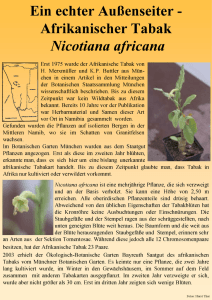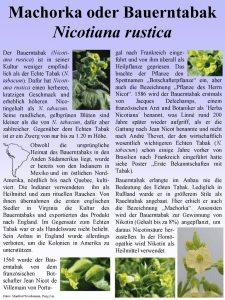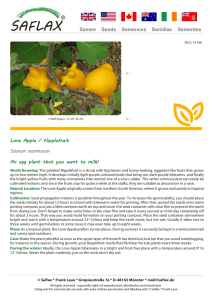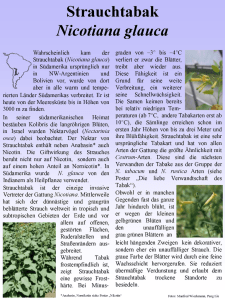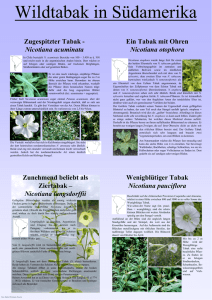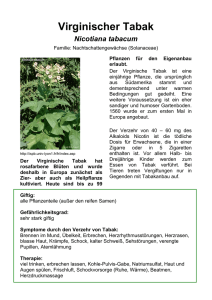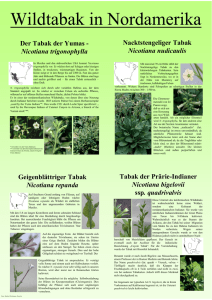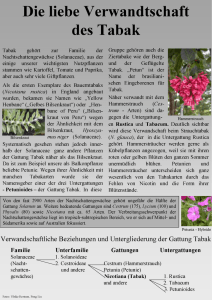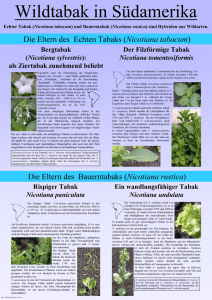Common Tobacco Nicotiana tabacum Fast-growing with
Werbung
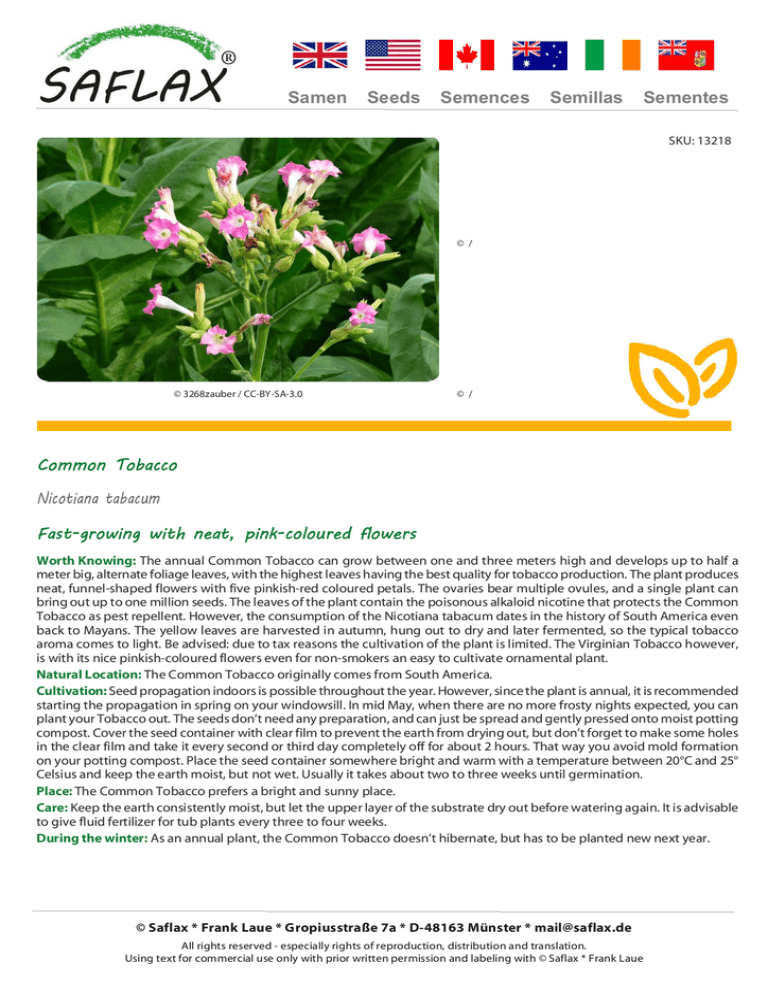
® Samen Seeds Semences Semillas Sementes SKU: 13218 © / © 3268zauber / CC-BY-SA-3.0 © / Common Tobacco Nicotiana tabacum Fast-growing with neat, pink-coloured flowers Worth Knowing: The annual Common Tobacco can grow between one and three meters high and develops up to half a meter big, alternate foliage leaves, with the highest leaves having the best quality for tobacco production. The plant produces neat, funnel-shaped flowers with five pinkish-red coloured petals. The ovaries bear multiple ovules, and a single plant can bring out up to one million seeds. The leaves of the plant contain the poisonous alkaloid nicotine that protects the Common Tobacco as pest repellent. However, the consumption of the Nicotiana tabacum dates in the history of South America even back to Mayans. The yellow leaves are harvested in autumn, hung out to dry and later fermented, so the typical tobacco aroma comes to light. Be advised: due to tax reasons the cultivation of the plant is limited. The Virginian Tobacco however, is with its nice pinkish-coloured flowers even for non-smokers an easy to cultivate ornamental plant. Natural Location: The Common Tobacco originally comes from South America. Cultivation: Seed propagation indoors is possible throughout the year. However, since the plant is annual, it is recommended starting the propagation in spring on your windowsill. In mid May, when there are no more frosty nights expected, you can plant your Tobacco out. The seeds don’t need any preparation, and can just be spread and gently pressed onto moist potting compost. Cover the seed container with clear film to prevent the earth from drying out, but don’t forget to make some holes in the clear film and take it every second or third day completely off for about 2 hours. That way you avoid mold formation on your potting compost. Place the seed container somewhere bright and warm with a temperature between 20°C and 25° Celsius and keep the earth moist, but not wet. Usually it takes about two to three weeks until germination. Place: The Common Tobacco prefers a bright and sunny place. Care: Keep the earth consistently moist, but let the upper layer of the substrate dry out before watering again. It is advisable to give fluid fertilizer for tub plants every three to four weeks. During the winter: As an annual plant, the Common Tobacco doesn’t hibernate, but has to be planted new next year. © Saflax * Frank Laue * Gropiusstraße 7a * D-48163 Münster * [email protected] All rights reserved - especially rights of reproduction, distribution and translation. Using text for commercial use only with prior written permission and labeling with © Saflax * Frank Laue ® Samen Seeds Semences Semillas Sementes Artikel-Nr: 13218 © / © 3268zauber / CC-BY-SA-3.0 © / Echter Virginischer Tabak Nicotiana tabacum Schnellwachsend mit hübschen, rosafarbenen Blüten Wissenswertes: Die einjährige Tabakpflanze wird ein bis drei Meter hoch und entwickelt große, bis zu einem halben Meter lange Laubblätter. Sie stehen wechselständig, wobei die höchsten Blätter auch die beste Qualität für die Tabakherstellung aufweisen. Der Tabak bildet hübsche, trichterförmige Blüten mit fünf rosa bis roten Kronblättern aus. Die Fruchtknoten sind mit zahlreichen Samenanlagen besetzt und eine Pflanze kann bis zu einer Million Samen erzeugen. Die Pflanze enthält in den Blättern das Alkaloid Nicotin. Es ist giftig und dient der Pflanze als Fraßschutz. Der Konsum von Nicotiana tabacum kann in der Geschichte Südamerikas allerdings bis in die Zeit der Maya zurückverfolgt werden. Im Herbst werden die gelben Blätter geerntet, zum Trocknen aufgehängt und später fermentiert, damit sich das typische Tabakaroma entwickeln kann. Achtung: Aus steuerlichen Gründen dürfen nicht unbegrenzt Tabakpflanzen angebaut werden. Der Virginische Tabak mit seinen hübschen, rosafarbenen Blüten lässt sich aber auch für Nichtraucher gut als pflegeleichte Zierpflanze halten. Naturstandort: Die ursprüngliche Heimat des Tabaks ist Südamerika. Anzucht: Im Haus ist die Anzucht aus Samen das ganze Jahr über möglich. Da die Pflanze einjährig ist, empfiehlt es sich allerdings, die Anzucht im Frühjahr im Haus auf der Fensterbank vorzunehmen und den Tabak im Mai nach den letzten Nachtfrösten in einen Kübel oder ins Beet nach Draußen umzusetzen. Die Samen des Tabak müssen nicht vorbehandelt werden. Streuen Sie sie einfach auf feuchtes Anzuchtsubstrat und drücken Sie sie leicht an. Spannen Sie Klarsichtfolie über das Anzuchtgefäß und stechen Sie einige Löcher in die Folie. So ist die Erde vor Austrocknung geschützt. Alle zwei bis drei Tage sollten Sie die Folie für 2 Stunden entfernen. Das beugt einer Schimmelbildung auf der Anzuchterde vor. Stellen Sie das Anzuchtgefäß an einen hellen und warmen Ort mit 20 bis 25° Celsius und halten Sie die Anzuchterde feucht, aber nicht nass. Die Keimung erfolgt in der Regel nach zwei bis drei Wochen. Standort: Ihr Virginischer Tabak bevorzugt einen hellen bis sonnigen Standort. Pflege: Halten Sie das Erdsubstrat gleichmäßig feucht, aber lassen Sie die Erdoberfläche auch immer leicht antrocknen. Eine Düngung mit flüssigem Kübelpflanzendünger empfiehlt sich im Abstand von drei bis vier Wochen. Im Winter: Als einjährige Pflanze wird der Tabak nicht überwintert, sondern im kommenden Jahr aus den Samen neu gezogen. © Saflax * Frank Laue * Gropiusstraße 7a * D-48163 Münster * [email protected] Alle Rechte, insbesondere das Recht der Vervielfältigung und Verbreitung sowie der Übersetzung, vorbehalten. Verwendung der Texte zum gewerblichen Gebrauch nur nach schriftlicher Zustimmung und unter Kennzeichnung durch den Zusatz © Saflax * Frank Laue
